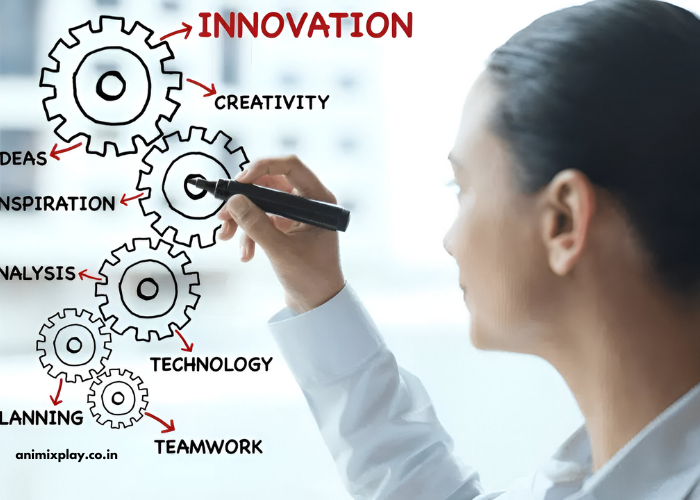In today’s rapidly evolving business environment, companies must continually adapt and innovate to stay competitive. A crucial factor that drives organizational growth and success is leadership. Innovative leadership practices play a pivotal role in shaping the direction, culture, and strategic initiatives that propel businesses forward. Effective leaders not only influence the internal dynamics of a company but also help it navigate market challenges, embrace new technologies, and foster an environment of continuous improvement.
This article delves into the innovative leadership practices that are critical for business growth, offering insights into how leaders can transform their organizations, inspire teams, and achieve sustainable success. We will explore key leadership practices, strategies, and examples that highlight how innovative leadership fosters business growth and competitive advantage.
Embracing Change and Fostering Innovation
At the core of innovative leadership is the ability to embrace change and encourage creativity. In the modern business world, change is inevitable. Technologies advance at a rapid pace, consumer preferences evolve, and global markets shift. To stay relevant, businesses must be agile, flexible, and willing to challenge the status quo.
An innovative leader creates a culture where employees feel empowered to suggest new ideas, experiment with different approaches, and challenge traditional norms. They encourage continuous learning and provide opportunities for employees to develop their skills and explore new technologies. Leaders who foster a culture of innovation create an environment where creativity thrives, resulting in the development of new products, services, and business models.
Practical Strategy:
- Regularly host brainstorming sessions or innovation workshops to generate new ideas and solutions.
- Recognize and reward creative thinking and risk-taking to motivate employees to push boundaries.
- Implement processes that allow for quick experimentation, feedback, and iteration.
Data-Driven Decision Making
Innovative leadership requires a commitment to making informed decisions. The rise of big data, analytics, and artificial intelligence has transformed the way leaders can make decisions. Leaders who leverage data not only improve operational efficiency but also enhance strategic decision-making processes.
Data-driven decision-making allows leaders to identify trends, track performance metrics, and anticipate market changes. It reduces the reliance on intuition and guesswork, leading to more accurate predictions and better outcomes. In business, using data to inform decisions can significantly impact growth by optimizing resource allocation, improving customer experiences, and identifying new business opportunities.
Practical Strategy:
- Implement advanced analytics tools to track key performance indicators (KPIs) and customer behavior.
- Use data insights to make informed decisions about product development, marketing strategies, and operational improvements.
- Regularly assess and refine data management practices to ensure accuracy and relevance.
Agile Leadership for Organizational Flexibility
Agility is another essential practice for innovative leadership. In a volatile and uncertain business world, an agile leadership approach allows organizations to respond quickly to changing conditions. Agile leadership encourages flexibility, adaptability, and collaboration, enabling teams to pivot and adjust their strategies as needed.
Agile leaders focus on outcomes rather than rigid processes. They encourage cross-functional collaboration, enable decentralized decision-making, and prioritize speed over perfection. By fostering a mindset of adaptability, agile leaders ensure that their teams can overcome challenges and seize new opportunities without being bogged down by bureaucracy or slow decision-making.
Practical Strategy:
- Adopt an agile framework for project management, such as Scrum or Kanban, to enhance collaboration and flexibility.
- Encourage iterative progress, with regular reviews and feedback loops to improve processes and results.
- Empower teams to make decisions autonomously, allowing for quicker responses to changing circumstances.
Empathy and Emotional Intelligence in Leadership
Innovative leaders are not only strategic thinkers but also emotionally intelligent individuals who can connect with their teams on a human level. Empathy and emotional intelligence (EQ) are key components of effective leadership. Leaders who understand and respond to the emotions, needs, and motivations of their employees can build stronger relationships, foster trust, and improve team dynamics.
An emotionally intelligent leader is more attuned to their employees’ challenges, which allows them to offer support, guidance, and encouragement. This creates a positive work culture that fosters collaboration, loyalty, and higher employee satisfaction. Moreover, empathy helps leaders navigate difficult conversations, resolve conflicts, and motivate employees during challenging times.
Practical Strategy:
- Practice active listening and engage with employees on a personal level to understand their concerns and needs.
- Foster an inclusive and supportive work environment where employees feel valued and respected.
- Use emotional intelligence to manage conflict, build trust, and inspire team cohesion.
Leadership Development and Succession Planning
Innovative leaders recognize that the growth of their business is closely tied to the development of their people. Leadership development and succession planning are vital components of long-term business growth. Effective leaders invest in the growth of future leaders by providing mentorship, training, and career development opportunities.
Succession planning ensures that there are capable leaders ready to step up when current leaders retire, move on, or face new challenges. By focusing on talent development, organizations can create a strong leadership pipeline that sustains the business’s growth and maintains a high level of performance over time.
Practical Strategy:
- Develop structured leadership development programs that offer mentoring, training, and leadership experiences for high-potential employees.
- Identify key positions within the organization that require succession planning, and prepare internal candidates for these roles.
- Encourage cross-training to ensure that employees can take on diverse roles within the company.
Collaboration and Partnership Building
Innovative leadership involves recognizing the power of collaboration, both within the organization and with external partners. Business growth is often driven by strategic partnerships and alliances. Leaders who understand the value of collaboration can drive business success by forming mutually beneficial relationships with other organizations, industry leaders, and even competitors.
By fostering a collaborative culture, leaders can create synergies that lead to greater innovation, enhanced problem-solving, and access to new markets and technologies. Partnerships with startups, research institutions, or other businesses can also provide new insights, access to cutting-edge technologies, and expanded customer bases.
Practical Strategy:
- Identify and cultivate strategic partnerships with organizations that complement your business goals.
- Encourage teamwork across departments and geographies to leverage diverse perspectives and expertise.
- Use open innovation models to collaborate with external entities to co-create new products or solutions.
Sustainability and Corporate Social Responsibility (CSR)
In the modern business landscape, corporate social responsibility (CSR) and sustainability are becoming increasingly important. Consumers and investors alike are placing greater emphasis on ethical business practices, environmental responsibility, and social impact. Innovative leaders who integrate sustainability into their business strategy not only contribute to the well-being of society but also create long-term value for their organizations.
Sustainability can be a powerful driver of innovation. By adopting sustainable practices, leaders can reduce operational costs, improve brand reputation, and tap into new markets. For example, investing in green technologies or sustainable supply chains can create efficiencies and attract environmentally conscious consumers.
Practical Strategy:
- Develop and implement sustainability initiatives that reduce waste, improve energy efficiency, and support social causes.
- Incorporate CSR into the core business strategy, aligning it with long-term goals and values.
- Engage employees in sustainability efforts, fostering a sense of purpose and pride in contributing to meaningful change.
Effective Communication and Transparency
Innovative leaders understand that clear, transparent, and frequent communication is crucial for fostering trust and aligning teams toward common goals. Communication is not just about conveying information—it’s about building relationships, ensuring everyone is on the same page, and motivating teams to achieve collective success.
Transparent communication helps mitigate misunderstandings and builds a culture of openness. Leaders who communicate effectively are more likely to inspire their teams, retain top talent, and build stronger relationships with stakeholders.
Practical Strategy:
- Implement regular communication channels such as town hall meetings, newsletters, or team check-ins to keep everyone informed.
- Be transparent about organizational goals, challenges, and changes, allowing employees to feel involved and valued.
- Encourage two-way communication, where employees can voice their opinions, ideas, and concerns.
Leveraging Technology for Business Growth
In the digital age, innovative leadership involves leveraging technology to drive business growth. From automation and artificial intelligence (AI) to cloud computing and the Internet of Things (IoT), technology has the potential to transform business operations, enhance customer experiences, and create new revenue streams.
Leaders who embrace technology can unlock efficiencies, reduce costs, and improve the scalability of their operations. Additionally, technology enables businesses to personalize customer experiences, improve data analytics, and enhance decision-making processes.
Practical Strategy:
- Invest in technologies that enhance operational efficiency, such as automation, AI, and data analytics tools.
- Use digital platforms to engage with customers, gather feedback, and personalize offerings.
- Stay informed about emerging technologies and explore their potential to create new business opportunities.
Conclusion: Cultivating Innovative Leadership for Sustainable Growth
Innovative leadership is a key driver of business growth and success in today’s fast-paced, ever-changing marketplace. By embracing change, fostering innovation, and prioritizing empathy, collaboration, and sustainability, leaders can create an environment where their organizations thrive.
Ultimately, the most successful leaders are those who understand that growth is not just about achieving short-term financial success but about building a resilient, adaptable, and forward-thinking organization. By adopting innovative leadership practices, businesses can position themselves for long-term success, navigate challenges with ease, and continuously evolve in response to the changing business landscape.
Through strategic vision, data-driven decision-making, and an unwavering commitment to people and innovation, businesses can unlock their full potential and pave the way for sustained growth in an increasingly competitive global market.




